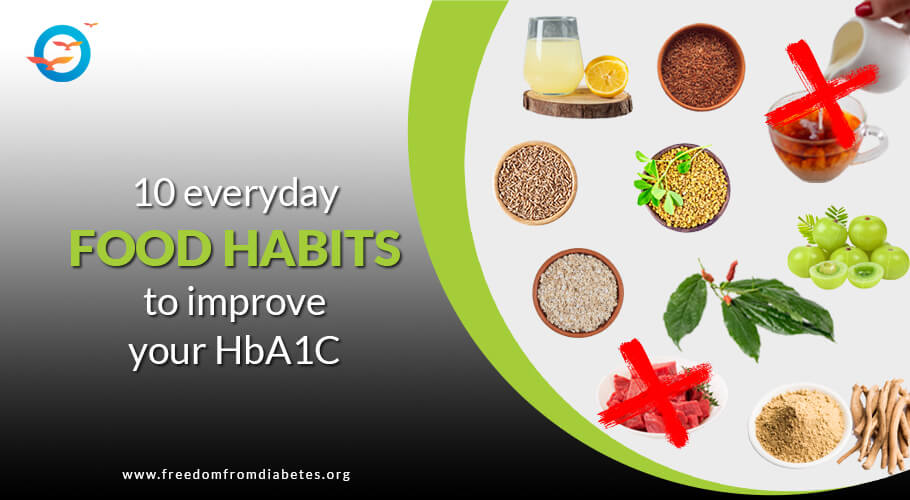10 Food-habits to reduce HbA1C

How to Reduce HbA1C?
Here is a list of foods to help lower HbA1C.
1. Like your cereal? Try this variety of oats.
Cereals have become the norm in our get-up-and-go urban lifestyles, but they often come loaded with unhealthy sugar and carbs, which push up blood sugar levels and set the stage for insulin resistance and lifestyle disorders like diabetes. Oats have always been considered healthy. And for good reason.
They are high in fibre, which is good for your digestive tract, and it also slows down the absorption of sugar into the bloodstream. But the health benefits you get from oats depends on the type of oats you eat and how they are cooked. Slow cooking steel cut oats offer the highest benefits, although they do take longer to cook.
Quick-cooking oats, like the pre-packaged varieties that are available, are certainly convenient, but the trade-off in cook-time comes at a price. These oats are partially pre-cooked, which raises their glycemic index and they often have added sugar to make them palatable.
If you’re keen to add oats to your breakfast routine, chow down on our article: Are oats good for diabetics, and get all the information you need to make a decision.
2. Cut out red meat
Given that carbohydrates cause blood sugar levels to spike, there is a natural increase in interest in meat products. But that’s no reason to switch to meat. Meat and animal products, in general, are high in saturated fat—a prime cause of insulin resistance. In addition, cooking creates a number of dangerous compounds in meat—especially red meat.
These compounds are bad for insulin sensitivity and increase the risk of certain types of cancers. There are many protein sources that are healthier and cleaner—for you and the environment. For more information about the dangers our red meat, read our article: Does red meat cause diabetes?
3. Lemon juice to manage blood sugar
Who doesn’t like a chilled drink of lemon juice on a hot summer’s day? But there’s more to lemon juice than its fruity flavour. This easy to prepare drink is loaded with good nutrition too. One of the biggest being its salutary effect on blood glucose levels. So power is its ability to prevent spikes that the American Diabetes Association (ADA) has included lemons in their list of diabetes superfoods.
Lemon juice is also an anti-obesity drink, thanks to the bioactive elements it contains, which help prevent and treat obesity. A glass of warm water with lemon juice makes it the ideal weight loss drink the world over for people to keep to shed excess weight.
Lemon juice is also good for the heart and is considered a potent hydrating agent. There are many good reasons to include lemon juice in your diet, and you can find out more about them in our article: Lemon juice, the diabetic superfood.
Who doesn’t like their morning cuppa chai. There’s something about a steaming hot cup of tea with sugar and milk that just wakes you in a good mood. About a billion Indians swear their morning rituals are incomplete without it. And tea does have several beneficial properties, starting with, surprisingly, its anti-diabetic properties. High levels of polyphenols—strong anti-oxidants—gives tea a powerful anti-inflammatory capacity.
Teas like oolong, green tea and black tea also contain flavonoids, which are also anti-inflammatory. Flavonoids are also believed to help control blood pressure and lower stress. Yet, all these positives disappear when you add milk to your tea. Not only is milk high in carbohydrates, it is also high in fat and known to use digestive problems (lactose intolerance) in about 70% of all humans.
Finally—and this is a big one—milk contains a compound known as Insulin-like Growth Factor (IGF). There is valid research—and Freedom from Diabetes has also published papers on this topic in reputed scientific journals—to show that IGF molecules compromise insulin function, causing high blood sugar. For all these reasons, Freedom from Diabetes strongly recommends cutting out all milk from your diet.
Our article, Is milk bad for diabetics, gives you the full low down. You can read it here.
5. Start your morning with fenugreek seed water
Many common herbs, spices and greens have found their way into Ayurvedic preparations, because of the many health benefits they offer. One of the most popular of these is the little fenugreek (methi) seed. This nutty little powerhouse punches well above its weight in the health leagues, offering a range of benefits from lowering blood sugar to raising testosterone levels.
For best results water in which the seeds have been soaked overnight should be consumed on an empty stomach in the morning. You can also chew the seeds after drinking the water. Five key benefits that the fenugreek provides include:
- Blood Sugar Regulation
- Weight Loss Promotion
- Enhanced Milk Production in Lactating Mothers
- Improved Digestion
- Higher Testosterone level
For detailed information on the benefits of the fenugreek seed, and how to have it, read our article: 5 reasons to add fenugreek (methi) seeds to your diet
6. Add this natural sugar destroyer to your diet
Gymnema Sylvestre, or Gudmar, as it is known locally in India, is so powerful an anti-diabetic, that its very name Gud-mar, translates into sugar killer. Several Ayurvedic preparations use it for its healing properties. It’s famous sugar killing properties come from its content of gymnemic acid—as bioactive compound that surpasses the sweet taste of sugar. Just chewing the leaves is said to activate this effect. The plant also contains other micronutrients like betaine, choline, and dquercitol, which are used as active ingredients in supplements to fight obesity.
Gudman libations are simple to prepare. Just gather about 20 leaves and boil them in clean water for some time. Allow to steep for some time, and sip through the day.
There are many of reasons to have gudmar, and you can learn more about this amazing properties of this rate plant, in our article: The sugar killer.
7. Amla(Gooseberry) for Diabetes Management
Amla, known as Indian Gooseberry, is commonly used by traditional medicine practitioners to treat several chronic conditions—like diabetes. This small green fruit has a distinctive sour-sweet taste that can be too tart for some palates, but the benefits are well worth the pucker.
It is so powerful that consuming just one amla a day is believed to provide a number of benefits, including regulating BSL, promoting weight loss, and strengthening the immune system. There is much to recommend this fruit for diabetes, and you can read all about them in our article: Amla(Gooseberry) for Diabetes Management.
8. Use Ashwagandha for blood sugar control
Ayurveda has shown us the amazing properties of several common fruits, herbs and vegetables, one of the most potent of these is Ashwagandha. Also known as Indian Ginseng, it is a powerful anti oxidant, with the ability to boost immunity and provide protection from common ailments.
Studies have also shown that Ashwagandha has properties that enable it to lower BSL. It is rich in anti-oxidants, anti-inflammatory and anti-microbial, micronutrients, that can protect from heart problems, help detox the liver, improve cognitive functions, and lower blood sugar levels.
Ashwagandha can be had orally as a powder or applied topically as a paste. However, excessive consumption of Ashwagandha can be toxic, so it is advisable to talk to a doctor or suitable medical professional before using it. To learn more about Ashwagandha, benefits, uses and precautions, read The amazing health benefits of Ashwagandha.
9. Eat this wheat for better blood sugar control
With some 70% of the human population reportedly suffering from some level of gluten allergy, it’s no surprise that wheat has come in for considerable flak the world over. It has also brought a considerable amount of heartache for those who count it as a staple. The humble chapatti/rote as our desi unleavened flatbread is known is a ubiquitous accompaniment to almost every meal on the Indian sub-continent.
For diabetics, especially, wheat has much to celebrate: it has a low glycemic index of 54, which makes it suitable for the diabetic diet, and it is high in fibre, which slows down the absorption of glucose in the bloodstream. Fibre also improves digestion and gut health. The downside of wheat consumption is that it triggers allergies in people with sensitive to gluten, causing pain, flatulence, bloating and loosies.
As a result of its high carbohydrate content, excess consumption can cause blood sugar to rise, which can trigger increases in LDL (bad cholesterol) levels. For diabetics who can’t do without their rotis, though, we have some good news. There are some wheat varieties that are easy to digest, have a low GI rating and are rich in much-needed minerals and vitamins.
Wheat varieties like emmer/Khapli, red wheat, spelt, and Bansi wheat offers a host of health benefits for everyone. For more information on these varieties and their health benefits, read our article: Best wheat varieties for diabetics.
10. Replace polished rice with these rice variants
Rice ranks high on the diabetes don’t-eat list, and with good reason. It has a high Glycemic Index (GI), a rating that ranks foods by the speed with which their glucose content is absorbed by the bloodstream.
Rice also has a high carb content, which increases the Glycemic Load (GL) on the body. But not all rice varieties are forbidden. There are several variants that are not just safe but beneficial as well. Brown rice, for instance, is a rich source of fibre, vitamins, and micronutrients that reduce inflammation from oxidative damage of free radicals.
Brown rice also contains magnesium, which along with its high fibre content reduces the risks of blood sugar spikes. Similarly, Red Rice (aka, Navara Rice), Black Rice and Hand Pounded Rice provide positive benefits not just for diabetics, but for everyone. To learn more about the health benefits of these variants, read our article: Best rice varieties for diabetics, here
For more information about diabetes-friendly foods and recipes, visit us at freedomfromdiabetes.org/blog or subscribe to our Facebook, Instagram and YouTube channels.
FAQs
Which food can reduce HbA1c?
Oats, Lemon juice, Fenugreek seed water, Amla. Adding vegetables contributes to a healthier meal plan that can get your A1c levels down.
Are there specific nutrients that can help lower HbA1c?
Foods that are high in fiber, protein and healthy fats can help stabilize your blood sugar levels, thus helping to lower HbA1c levels. These nutrients slow down the breakdown of carbohydrates into sugar, which helps prevent spikes in blood sugar levels.
Can I lower my HbA1c in a month?
HbA1c reflects your average blood sugar over about 120 days, so it takes a full 120-day cycle to see significant results. However, small changes in HbA1c levels can be noticed within a month.
What is HbA1c and why is it important?
A hemoglobin A1C (HbA1C) test is a blood test that shows your average blood sugar (glucose) level over the past two to three months.
Which help to monitor and manage diabetes more effectively.
How long does it take to lower HbA1c levels?
It takes about 2 to 3 months to lower HbA1c levels, as it reflects your average blood sugar over that time.
Is Lemon juice good for diabetes?
Yes, lemon juice is good for diabetes as it has a low glycemic index, supports digestion, boosts hydration, and provides vitamin C without causing blood sugar spikes.

